UPDATED TUESDAY MARCH 11, 2008
Both the Economy and Stock Markets are unfolding, almost as if on cue to the play I have been writing during the last year or so. I am not sure whether to be happy or sad as more and more analysts begin to see the dangers that lie beneath the surface and recognize the far reaching effects of the problems You may recall that I was always kind of hoping that this time I would be completely wrong. While it’s nice to get a little company after standing alone; I am sure we would all rather be wrong than have to bear witness to what’s coming.
Why did Bernanke cut the Fed Funds rate by an unprecedented inter-meeting 75bps, followed two weeks later by another 50bps? The flow of bad news in December to mid-January did not, by itself, justify such radical action. In order to understand these moves, one has to read between the lines and ignore the Pollyannish babbling of our Media, Politicians and Financial pundits and look instead at the rising probability of a "Catastrophic" financial and economic collapse (1930’s type depression). It now looks like the Fed is seriously worried about the risks, the likes of which have not been seen since the 1930’s. After a year in which the FED and the Treasury were underplaying the economic and financial risks – The FED has been pressured into taking a very aggressive, wrong headed, Keynesian(Socialist) approach to risk management. To understand the risks that the financial system is facing, let us examine the "nightmare" scenario that financial officials around the world have suddenly become aware of and which can no longer be swept under the rug. To begin with let us assume that the recession, which we will soon discover, started in the last quarter of 2007, will be much worse than those that occurred in 1990-91 and 2001-02 for several reasons. First, we have the biggest housing bubble/bust in US history with some home prices likely to eventually fall 30% to 50% or more. Second, because of deregulation and the elimination of Glass Steagall and a host of other protections put in place (after the last financial debacle) by the Securities Act of 1933-34, a massive credit bubble/crunch was created that has now gone far beyond just sub-prime mortgages. Third, deregulation has caused reckless financial innovation and securitization, causing the FED to lose complete control of the money supply, leading to the worst credit crunches in American history. Fourth, US household consumption which now accounts for more than 70% of GDP have spent well beyond their means for 15 years, piling up massive amounts of debt. Now that home prices are falling and a severe credit crunch is emerging, the retrenchment of private consumption will be serious, longer lasting and far reaching.
The Ten Steps to Financial Armageddon
1. The worst housing recession in US history and there is no sign that it will bottom out any time soon. US home prices will fall between 30% and 50% from their blow-off peaks which would wipe out between $5 and $10 trillion of equity, making the 1987 and 2001-2002 equity destruction look like chump change. While a 20% home price drop will translate into a sub-prime meltdown of about 2.2 million foreclosures, a 50% fall in home values will result in over 13 to 18 million households ending up with negative equity in their homes. What will that do to consumer spending? It won’t be long before a few large home builders go bankrupt, leading to another free fall in home builders' banks and related stock prices. The perennial Bulls, looking at last years earnings began bottom fishing and rallied these stocks in spite of the worsening housing recession, thus giving us a perfect opportunity to short the Home Builders and Banks.
2. The financial system losses from the sub-prime disaster are now estimated to be as high as $250 to $300 billion. But the financial losses will not be restricted to sub-prime mortgages and their related CMOs and CDOs. They are now spreading to near prime and prime mortgages as the same reckless lending practices, i.e. LIAR loans (no down-payment, no income verification interest rate only, negative amortization, teaser rates), were occurring across the entire spectrum of mortgages. All of which were being pushed by Greenspan and the Government promoting the American Dream. Instead, what they have created will be the Great American Nightmare. 60% of all mortgage origination between 2005-2007 had these suicidal features. What happened to risk underwriting? Goldman Sachs now estimates total mortgage credit losses of about $400 billion, but that is based on home prices falling only 20%. The markets for securitization of mortgages - already dead for sub-prime and practically frozen for other mortgages – further reduces the ability of banks to originate mortgages and as their risk tolerance is ever increasing, so are the minimum down-payments and credit score requirements. The huge losses have forced banks to bring back on to their balance sheet all types of toxic off-balance sheet investments and loans turning them into financial Time Bombs. Because of securitization, the toxic waste has spread from the major banks and brokers to their Investors, Pension Funds, Insurance Companies and Money Market Funds in both the US and abroad; increasing rather than reducing systemic risk as well as globalizing the credit crunch. The rest of the world will not be growing fast enough to pull the US out of recession.
3. The recession will cause a sharp increase in defaults in all other forms of unsecured consumer debt such as credit cards, auto loans, student loans, etc. As the Fed Loan Officers Survey suggests, the credit crunch is spreading from mortgages to consumer credit, and from large banks to smaller banks, it is becoming clear that the losses are much higher than the $10-$15 billion rescue package that regulators are trying to put together. The Monolines are actually borderline insolvent if not out and out bankrupt and none of them deserves a AAA rating regardless of how much recapitalization is provided. Any business that requires an AAA rating just to stay in business is a business that does not warrant an AAA rating. However, any downgrade of the Monolines will lead to another $150 to $250 billion of write-downs since it will also lead to huge losses on their portfolio of Muni Bonds. Just their downgrade will spillover into large losses and potential runs on the Money Market Funds that have relied on those AAA ratings. The Money Market Funds that are backed by banks or that bought liquidity protection from banks against the risk of a fall in the NAV may avoid a run, but such a rescue will exacerbate the capital and liquidity problems of their underwriters. Any Monolines' downgrade would lead to another sharp drop in US equity markets already shaken by the risk of a severe recession and large losses in the financial system but worst of all, to a general loss in overall CONFIDENCE. NOTE: The current Monoline rescue talk and/or plans is providing yet another short selling opportunity.
5. As I have been warning you, the commercial real estate loan market will sooner or later enter into a meltdown similar to that of the sub-prime one. Lending practices in commercial real estate were as reckless as those in residential real estate. The recession led by the housing crisis will lead, with a lag, to a bust in non-residential construction. The CMBX index is already pricing in massive increases in credit spreads for non-residential mortgages/loans.
6. It is highly probable that some large regional or even national banks will go bankrupt in the near future. This, like in the case of Northern Rock, will lead to a depositors' panic and concerns about deposit insurance. The Fed will have to reaffirm the implicit doctrine that some banks as well as Fannie and Freddie are too big to fail as well as the FDIC’s Deposit Guarantees. The bank’s losses on their portfolio of leveraged loans are already large and growing. The ability of financial institutions to syndicate and securitize their leveraged loans - a good chunk of which were issued to finance very risky and reckless LBOs - is now or soon will be frozen as another prop to the stock market goes into the DEEP FREEZE. Hundreds of billions of dollars of leveraged loans are now stuck on the balance sheet of financial institutions at values well below par (currently about 90 cents on the dollar, but soon to be much lower). Add to this the many reckless LBOs (as senseless LBOs with debt to earnings ratio of seven or eight had become the norm during the go-go days of the LBO, Pvt. equity bubble) have now been postponed, restructured or cancelled. The problem worsens by the fact that some large LBOs will end up in bankruptcy as some of those corporations that were taken private will go bankrupt in a recession and given the re-pricing of risk, convenant-lite and PIK toggles may only postpone - not avoid - such bankruptcies and make them uglier when they do eventually occur. The leveraged loan mess has already frozen the LBO market leading not only to growing losses, but the elimination of a very lucrative source of income for financial institutions.
7. Once a severe recession is underway, a wave of corporate defaults will take place. In a typical year, US corporate default rates average about 3.8% (for 1971-2006); in 2006 and 2007 this figure was a puny 0.6%. This was due to the lax lending requirements and ultra low interest rates. In a typical US recession, such default rates surge above 10%. Also, during such distressed periods, the recovery given default (RGD) rates are much lower, adding to the total losses from a default. Default rates were very low in the last two years because of a slosh of liquidity, easy credit conditions and very low spreads (with Junk Bond yields being only 260bps above Treasuries until mid June 2007). But now the re-pricing of risk has been massive and Junk Bond spreads are close to 700bps, while the Junk Bond market is now practically frozen.
While on average the US and European corporations are in better shape in terms of profitability and debt burden than in 2001, there is a great many corporations with very low profitability that have piled up a mass of Junk Bond debt that will soon require refinancing at much higher spreads: Corporate default rates will then surge well above the recession average of 10%. Once both defaults and credit spreads are higher, massive losses will occur among the credit default swaps (CDS) that provided protection against corporate defaults. Losses on CDS’s do not represent only a transfer of wealth from those who sold protection to those who bought it. If some of the counterparties selling protection, i.e. banks, hedge funds and large broker dealers go bankrupt, even greater systemic risk results as those who bought protection face counterparties who cannot pay.
8. Unlike banks, non-bank financial institutions such as GE Credit and GMAC etc. don't have direct or even indirect access to the central bank's lender of last resort facility, as they are not depository institutions. In the event of financial distress, they may go bankrupt not because of insolvency, but for lack of liquidity and their inability to roll over or refinance their short term debt, especially since they cannot be directly rescued by the central banks in the same way banks can.
9. Soon, perhaps after one last wishful thinking, short-covering rally, stock markets around the world will begin pricing in a severe US recession as well as a global economic slowdown. The drop in stock markets around the world will then resume with a vengeance as investors begin to realize that the economic downturn is much worse than they ever imagined. Long equity hedge funds will go belly up as large margin calls are triggered leading to a cascading fall in equity prices as a Bear Market is recognized. While a typical US recession causes the S&P 500 to fall by about 28%, this Recession/Depression will not be typical and I am looking for losses in the 50% plus range.
10. Using Economics 101, $200 billion in losses in the Banking system, given a reserve requirement of 10%, leads to a contraction of credit of $2 trillion. Even the recapitalization of banks by sovereign wealth funds (SWF) - about $80 billion so far - will be unable to stop this credit (money supply) contraction. A contagious and cascading spiral of credit contraction, sharp fall in asset prices and widening credit spreads will then be transmitted to most parts of the financial system. This massive credit crunch will make the economic contraction even more severe and the economic recession will become deeper and more protracted. A global economic recession will follow as the credit crunch spreads around the world. A cascading fall in asset prices will cause panic, fire sales and exacerbate the real economic distress as a number of financial institutions go bankrupt. A 1987 style stock market crash could occur leading to further panic. Monetary and fiscal easing, as I have previously explained, will no longer work and will not be able to prevent a systemic financial meltdown. The lack of trust in counterparties driven by the lack of transparency in financial markets and uncertainty about the size of the losses and exactly who is holding the toxic waste securities, will add to the impotence of monetary policy and lead to massive hoarding of liquidity. In this meltdown scenario, the US and global financial markets will experience their worst crisis since the 1930’s.
HOW SAFE ARE WE?
The great false hope.
Ambac had, at one time, a capitalization of $US 5.7 billion, with which it guaranteed bonds of $US 550 billion! REALLY! A 1% misstep wipes out its entire capital. How safe will we be even after some back room engineered re-capitalized bail-out designed primarily to help maintain the dubious AAA ratings. And we call this insurance?
What about the general and much broader US Insurance System which covers
everything from life insurance to fire and accident all the way to hurricanes, tornados and floods? All the US insurance companies will be reporting their financial status by the end of February, but only as of the end of 2007. Being so big, they hold enormous investments in all forms of US financial paper from stocks to commercial bonds, CDOs, CMOs etc. and US Treasuries. Their losses on these investments are certain to be huge, but their report will not reflect their true status because the realization of the damage took place in 2008. Since they do not have to mark to the market every day, their true losses will be even bigger after the market falls further, later this year. The issue now becomes: How “safe” are they?
WHAT CAN BE DONE?
One thing for sure, obfuscation, misinformation and politicizing every problem, large or small, will only make it worse. A recession is inevitable, a depression is not. If Bernanke and the Government can work together to control the recession but allow the economy and the securities markets to heal themselves, while mitigating the harmful effects of the recession, then we may avoid a depression. But if an all out effort is undertaken to stop the recession from running its course, as Wall St is demanding, then matters will get a lot worse instead of better. Can our politicians, the Fed and other financial officials come together and avoid this nightmare scenario? Probably not, unless they all hand in their Keynesian credentials and suddenly read and adopt Austrian Economics, recognize the real problems and are able to differentiate cause from effect. Nevertheless, the answer to this question will depend on whether the policy responses (monetary, fiscal, regulatory and financial) are coherent, timely and credible.
I would not bet on it! My philosophy always remains the same regardless of the situation: “HOPE FOR THE BEST, EXPECT AND PREPARE FOR THE WORST, YOU WILL NEVER BE DISAPOINTED”.
WHAT TO DO NOW?
SELL, SELL, SELL: We are in a BEAR MARKET for BONDS and STOCKS. Get out of all your bonds and money markets NOW! Short Term Treasuries and CDs are ok. Although the FED may try to continue to cut rates, because of our weak dollar they may not be able to. But regardless if they do or not, long term rates will be increasing as sanity finally returns to the marketplace and risk once again becomes part of the cost of borrowing.

The 64.2 % reading was high enough to set the stage for the substantial Pull-Back rally into the Bernanke trip to Washington.
Sell and go short into any 450 to 750 point (38%) DJII retrenchment rally. You can now buy Puts on the ETF’s that you think are the most vulnerable such as the XLF (Financials) or you can buy the pro ETF’s that go up when their related indexes go down (i.e QID represents double down the QQQ’s) AND/OR you can just accumulate more GOLD and SILVER stocks and Bullion.
NOTE: This is not a handholding Day Trading Letter, so don’t expect specific option or stock trading recommendations. I only name buy and hold LT positions.
GOLD
The Selling Of IMF Gold: Calls Attention To The REAL Problems.
Ever since its beginnings in the late 1940s, IMF Gold sales have always coincided with a last ditch emergency act in response to a global monetary crisis. Only Gold stands as a valid alternative to failing Fiat monetary systems. IS IT CRISIS TIME AGAIN? Every time the IMF has sold “official” Gold, it soared. In the late 1970s, as US consumer prices were soaring, both the IMF and US Treasury were selling Gold out of their respective inventories. The response to that was Gold gapped up $20 to $40 at every auction. So instead of with dread or fear, I welcome IMF Gold sales.
RIDING THE GOLDEN BULL
The early 1970’s saw Gold go from $35/oz to $200/oz., a 570% increase in less than three years which, at the time, marked the end of Wave I only. A similar move today since we are now in the final stages of Wave I , just like we were back in 1975, would give us a target of ($250 X 5.7) $1425 and that would only complete a 7 year Wave I of an ongoing 5 wave, 16 to 20 year Bull Market for Gold. Do I have to spell it out for you what you should be investing in?
SENIORS vs JUNIORS
Both the Juniors and to a lesser extent the Seniors and Mid Caps have been lagging the rise in the Gold price, instead of leading it as they usually do. Let us now all complain and keep looking a gift horse in the mouth instead of slowly and quietly doing our homework and accumulating the once in a lifetime bargains that are staring us all in the face.
Usually it is “hurry up and buy before the bargains run away”. My crystal ball is a little cloudy, but I am convinced that in the not to distant future, they will catch up and surpass Gold and Silver Bullion. I am running out of time and space, so if you want to know why this abnormal occurrence is happening, you will have to wait for my next letter or go to Gold-Eagle.com where you will find a good number of knowledgeable Gold and Silver people. In the meantime, my TUNE has not changed for the last SIX years: BUY - DO NOT TRADE. Buy more on dips and retrenchments and hang on for dear life as the GOLDEN BULL will definitely try its best to buck you off.
NEW POSITIONS
Bought Miranda Gold (MRDDF) at $0.58 and looking to Buy March in the money Puts today on C, JPM, LEN and LOW
GOOD LUCK AND GOD BLESS
February 27, 2008,
MY SUBSCRIPTION LETTER, “UNCOMMON COMMON SENSE” was started Feb. 1st. We are now living in the type of times in which you will definitely want to be kept abreast as to what is really happening on a regular bi-weekly basis. A 3 month trial subscription is only $55. One Year $199: Call for more info.
Aubie Baltin CFA, CTA, CFP, PhD.
2078 Bonisle Circle
Palm Beach Gardens FL. 33418
aubiebat@yahoo.com
561-840-9767
Please Note: This article is for education purposes only and is designed to help clarify your thinking, not lead it. Only you can decide the best places to invest your money and the degree of risk that you are prepared to take. The Information or data included here has been gleaned from sources deemed to be reliable, but is not guaranteed by me and may have already been overtaken by events. Nothing is stated here should be taken as a recommendation to buy or sell securities. Consult with your own financial advisor before making any investment decisions.
.38 Special LSWCHP +P: Still a Top Load?
By Stephen Camp
Despite improvements in popular defense calibers like 9mm and .45 ACP as well as some new ones such as .40 S&W, .357 SIG, and .45 GAP, the .38 Special continues to sell as a self-protection round. With the police move to autos in the '80's, the "shakers and movers" in this caliber are now the snub revolvers. This is probably due to the concealed handgun licensing laws allowing private citizens to legally carry. In police circles, the .38 Special fills but a few duty holsters these days, just the opposite of a few decades ago. It still serves in the role of back up for more than a few lawmen.
Just as was the case 30 years ago, the .38 Special just didn't "shine" as a top "stopper" in any barrel length. The traditional 158-gr. LRN bullet loped along at some 800 ft/sec from the usual 4" barrel and the picture grew bleaker when using short-barreled revolvers.
Super Vel sought to change this with a hot 110-gr. JHP and eventually other ammunition manufacturers began doing the same. Commercial ammo used bullets from 90 to 158 grains with the most popular seeming to be in the 110 to 125-gr. weight range. It seems that some improvement in "stopping power" was observed over the old 158-gr. solids as well as the pitifully slow 200-gr. "Super Police" round nose load that was becoming almost nonexistent.
A popular defense load for the .38 Special appeared during this same time frame. It has been referred to as "The FBI Load" or "The Chicago Load" and I've seen it called "The Dallas Load" a few times. Whatever it was called, the round consisted of a lead SWC with a deep hollow cavity loaded to +P pressure.
It seemed to hit closer to point of aim in the fixed sight revolvers common at that time and field reports indicated that it was fairly effective. It is a safe statement that this load became quite popular whether offered from Remington, Federal, or Winchester. I do not recall which came out with it first.
Today, it still remains the top choice for some people, but is being challenged by some "new technology" bullets said to work more reliably over more varied conditions. Corbon has a light-for-caliber X-bullet, which penetrates more deeply than might be expected, and Speer is offering a mid-weight 135-gr. Gold Dot designed especially for use in shorter barrel lengths. Both are also loaded to SAAMI +P pressure levels and a myriad of 110 and 125-gr. JHP's are available as well.
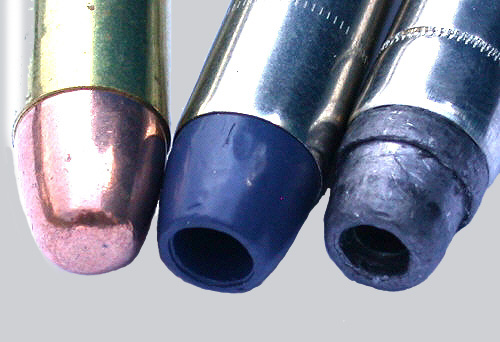
Here are three cartridges for the .38 Special. From left to right: 130-gr. FMJFP, standard velocity 125-gr. Federal Nyclad hollow point, and a Remington 158-gr. LSWCHP +P. The FMJ is almost always used for practice while the other two were designed to expand in soft targets. The Nyclad was originally a SWC design intended for indoor target work. They were offered in both standard and +P loads, but neither is available from Federal today for use by private citizens. Both these hollow points would be considered "old technology."
Though most attempted to up the .38 snub's "stopping power" with higher velocities and better bullet design, one school suggests using the old 148-gr. full wadcutter, citing that many expanding designs simply don't after passing through 4-layers of denim before striking 10% ballistic gelatin. They cite sufficient penetration and low recoil being characteristic of this load. After all, if the expanding bullets don't after passing through the denim, why not go with the lighter, easier to shoot wadcutter?
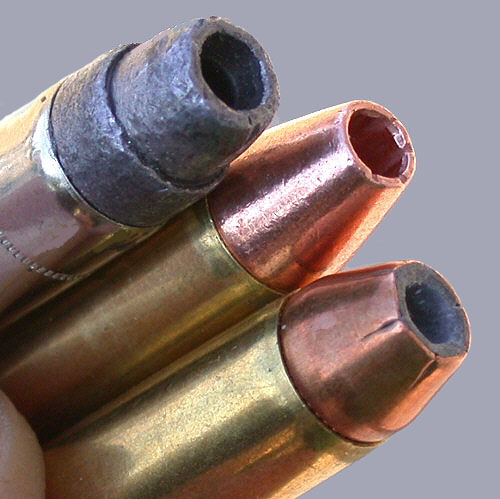
Here we see the LSWCHP next to one of the latest entries, the homogeneous copper alloy Corbon DPX. At the bottom is the aggressive expanding JHP loaded to +P+ pressures. All are above standard pressure levels and approach enhancing "stopping power" differently. The "old technology" LSWCHP might be thought of as a homogeneous bullet like the DPX. It has no copper or jacket while the DPX has no lead. The LSWCHP is in the traditional weight and moves between 800 and about 900 ft/sec depending upon barrel length. The DPX is lighter and averages just under 1100 ft/sec from my snubs. The hot Corbon 115-gr. +P+ is no longer sold. This one exceeds 1180 ft/sec from a 1 7/8" barrel! Frankly, I'm hesitant to shoot it in my personal revolvers for fear of possibly cracking the thin forcing cone walls.
Thus, we see different approaches to a common problem and different criteria by which to judge effectiveness. Though kinetic energy figures were very commonly used to describe stopping power in the past, it is considered almost sacrilege to do so today. Some continue to go for higher than normal velocities with superbly designed expanding bullets while others go with a lighter recoiling flat solid, but the LSWCHP +P continues to sell and remains a very popular choice.
Why is this so?
-
My own reasons for sticking with this "old technology" load are several.
- It has had time to develop a "history." It has been used against human opponents enough to actually see that it "works" more than it "fails."
- Because it is in the traditional bullet weight, POI is usually quite close to POA in fixed sight revolvers.
-
In the lightweight revolvers, recoil is present to be sure, but it doesn't seem as sharp as with the fast, light-for-caliber bullets. (An example would be Corbon's 110-gr. JHP +P, not DPX.)
- This load can be found at more places than many of the newest loads, but it too can sometimes be elusive.
- It performs well in 3 and 4" barrels and allows for a single, reasonably effective load in all my 38-caliber revolvers.
Where the 158-gr. LSWCHP seems to fall from favor is when it is fired from 2" revolvers through 4-layers of denim before impacting 10% ballistic gelatin. This protocol is described by its supporters as a "worst case scenario" and not necessarily realistic. They opine that if a bullet will expand after punching the denim, it will usually do so for real and under most circumstances. (Note: This doesn't seem to be a problem when the LSWCHP is fired from 3" or longer barrels.) For this reason, the group supporting the denim test usually suggests using the 148-gr. wadcutter in the snub .38 revolver. They cite that it gets plenty of penetration, has low recoil, and does as good as an expanding bullet that doesn't expand.
Some of this makes sense to me. The wadcutter does kick less. It does penetrate sufficiently, at least in gelatin, but having chronographed some from an S&W snub at a "blazing" 541 ft/sec, I somehow don't think that this is quite as wise a choice as some might imply. Before I retired as a police officer, I spoke with a young man who'd been shot but a moment before with a .38 Special snub. He was sitting on the curb and looked like he wasn't feeling very good, but he could easily have pulled a trigger had he a gun and the inclination. It turns out that he died four minutes later in the ambulance I called.
He'd been shot through the heart with a .38 Special 148-gr. wadcutter.
I spoke with two officers from other agencies that had been forced to use their snubs against felons. Each was using the 158-gr. LSWCHP +P, but I don't remember which brand. Each decked an opponent with a single shot each to the chest. If memory serves, one of the crooks died, but both stopped and dropped when shot. I'm sure that there have been failures as well, but often wonder how much of this might be due to less than good shot placement because the little snubs can be difficult to shoot accurately if one is not practiced with them.
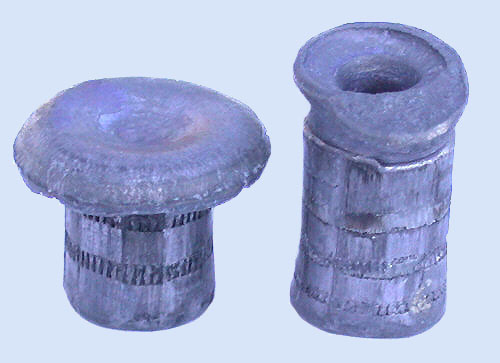
These bullets were fired into water from 2" .38 Special revolvers. The bullet at the left is from Remington and is softer than the deformed, flattened one on the right, which is from Winchester. (I am not sure where the Federal version falls in lead composition.) To me, the Remington is the better choice if a snub is being used. The Winchester sort of morphed into a wadcutter, but is traveling significantly faster so I'd pick either before I'd go with a target wadcutter as is sometimes suggested. When fired through the dreaded 4-layers of denim, the Remington acts about like the Winchester when the latter is fired directly into water. To me this still beats the wadcutter.
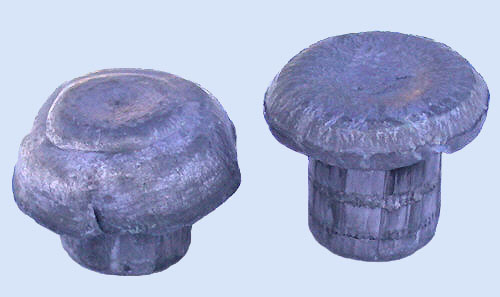
Again we see the expanded Remington (left) and Winchester 158-gr. LSWCHP +P's after being fired into water. This time there is less dramatic differences in expansion. That's because they were fired from 4" barrels. If my revolvers had barrels no shorter than 3", it wouldn't make me a lick of difference which was used. I'd probably go with whichever grouped best or cost less. In the snub, I definitely prefer Remington.
Though I've not tested them yet, the Speer 135-gr. Gold Dot "Short Barrel Load" appears to be very promising. It has a soft jacket with more copper content than traditional gilding metal and the bullet is reportedly designed to expand well at .38 snub velocities and to do so after passing through 4-layers of denim. (The DPX is said to do this as well.)
From a 2" vented test barrel, Speer reports that the 135-gr. Gold Dot +P averages 860 ft/sec. From my "slowest" barrel Model 642, Remington's 158-gr. LSWCHP +P hits 800 ft/sec with monotonous regularity.
With the Speer we have 7.5% more velocity, but trade 14.6% bullet weight to get it. Until I get a chance to really look at how this stuff performs, I believe I'll just stick with the old style LSWCHP.
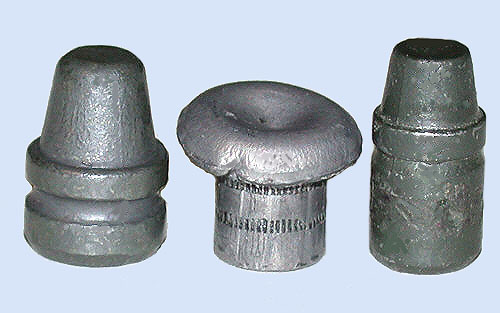
From left to right we have an unfired 45-caliber 200-gr. SWC, an expanded Remington 158-gr. LSWCHP +P, and an unfired 38-caliber 158-gr. SWC. At reasonably similar velocities which appears to be capable of leaving the largest diameter permanent cavity? The LSWCHP normally penetrates between 14 and 16" of 10% ballistic gelatin. The one I saw recovered from a previously wounded deer expanded in a fashion similar to the one in the picture, but was more uneven. It was fired from a 1 7/8" S&W Model 60.
Can we make the .38 Special a more potent load? Yes, I think we can, assuming that bullet placement remains in the equation, but I just don't think that it will ever be the "stopper" that some other calibers are. I try and pick what I believe to be a "good" load and then concentrate on practice. The 158-gr. LSWCHP +P from a snub S&W revolver is about as low on the ballistic totem pole as I care to go.
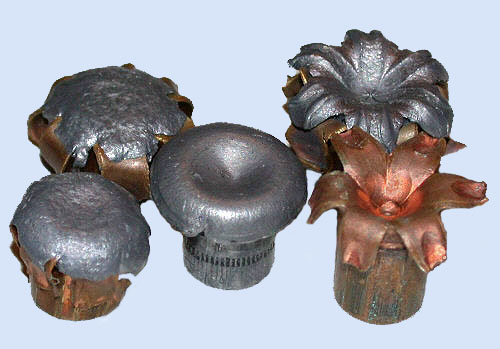
Here we see the Remington 158-gr. LSWCHP +P (center) compared to some other popular defense loads in other calibers. All were fired into water. Top Left: 9mm 127-gr. Winchester Ranger fired from a Browning Hi Power. Top Right: .45 ACP 230-gr. Ranger fired from 5" Kimber. Bottom Left: Hornady 90-gr. XTP fired from a Bersa. Bottom Right: Corbon .357 Magnum 125-gr. DPX fired from 2 1/2" S&W Model 19. I suspect that the 9mm, .357, and .45 loads are more likely to incapacitate quicker than the .38 LSWCHP +P, but still submit that this load is worthy of consideration in a snub. Its effectiveness is no doubt better in a 3 or 4" barrel revolver.
Some report problems with leading, but I've not seen this in any S&W, Colt, or Ruger revolver that I've fired this ammunition through. I have seldom fired more than 50 shots at a time, however, and I reckon it is possible if firing more than that between cleanings or in a rough bore.
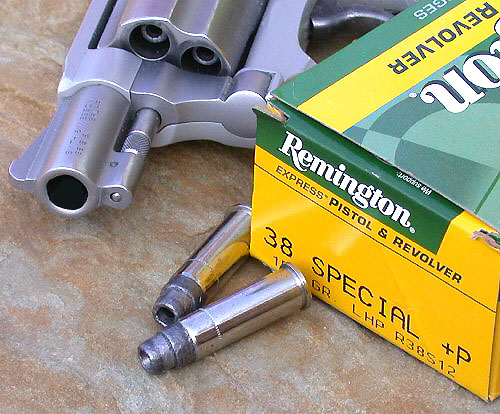
Until I get the chance to personally try more of the latest loads for the .38 Special and see how they are performing in the real world, I'll just stay with this old load.
For those interested, here are some average 10-shot velocities for this Remington round:
S&W Model 642 with 1 7/8" bbl: 800 ft/sec
S&W Model 19 with 2 1/2" bbl: 860 ft/sec
S&W Model 64 with 3" bbl: 883 ft/sec
Ruger GP100 with 3" bbl: 894 ft/sec
Ruger SP101 with 3 1/16" bbl: 906 ft/sec
S&W Model 10 with 4" bbl: 888 ft/sec
I cannot say if the newer attempts to increase the .38 revolver's "stopping power" are better, worse, or about the same as the old lead hollow point; they just have not had time to produce a track record. In the meantime, I'll stay with the LSWCHP +P in my .38 Special revolvers…but I'll be looking at the new stuff, too!
************************************************************************************
www.truthaboutparts.blogspot.com
www.tjofsugarland.blogspot.com
www.handgunpartsforsale.blogspot.com
www.hipowersandhandguns.comhttp://www.spw-duf.info/links.html#guns
***************************************************************
Primer on Personal Security 2. On webbing: These items are within arms reach all the time, and include: Midway Equipment, Supplies, How-to Books Wideners Reloading & Shooting Supplies Gun Owners of America: For an organization in Australia comparable to the NRA check: Sporting Shooters Association of Australia Inc. Additional Links and Information holly@standeyo.com
1. On the person: These items are on you at all times, and include:
3. In pack: These packs should be stored "ready to go" in an area that can be accessed very quickly, i.e. keep one in the house, one in your vehicle etc. and include:
5875-D W. Van Horn Tavern Rd.
Columbia, MO
1-800-243-3220
FAX 573-446-1018
http://www.wideners.com
P.O. BOX 3009 CRS
Johnson City, TN 37602
Phone: 423-282-6786
Fax: 423-282-6651
Order Line Only: 800-615-3006
1-800-672-3888; http://www.nra.org/
8001 Forbes Place, Suite 102
Springfield VA 22151
Phone: 703-321-8585
Fax: 703-321-8408
http://www.gunowners.org/
P.O. Box 906
St. Marys, NWS 1790
Phone: 02-9623-4900
Fax: 02-9623-5900
http://www.ssaa.org.au/
OWNING FIREARMS IN AUSTRALIA
http://standeyo.com
Contents © 1996-2008 Holly Deyo. All rights reserved.

